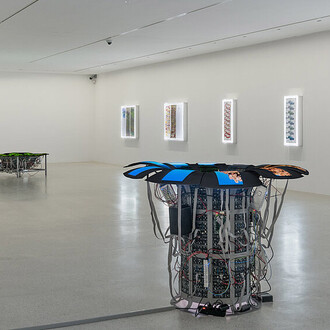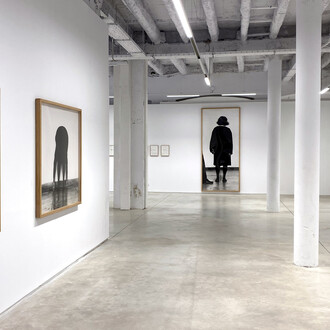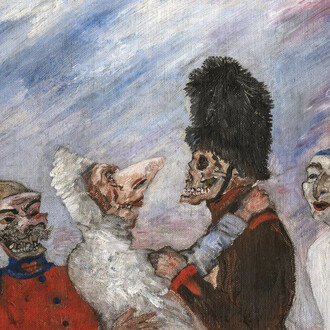AplusB contemporary art is pleased to announce L’avventura / Die mit der Liebe spielen, a group exhibition curated by Lena Ipsen with works by the following eleven artists: David Czupryn (1983 in Duisburg), Robert Elfgen (1972 in Wesseling am Rhein), Max Frintrop (1982 in Oberhausen), Tobias Hoffknecht (1987 in Bochum), Melike Kara (1985 in Bensberg), Valerie Krause (1976 in Herdecke), Michail Pirgelis (1976 in Essen), Dennis Scholl (1980 in Hünfeld), Jana Schröder (1983 in Brilon), Philip Seibel (1980 in Hagen) and Stephanie Stein (*1972 in Kiel).
The exhibition title L’avventura / Die mit der Liebe spielen refers to the Italian and German titles of a film from 1960 by Michelangelo Antonioni (English title: The Adventure), one of the most important protagonists of Neo-Realism. The title thus pays homage to this particular Italian-born film genre. The plot can be understood as a metaphor for the quest of the artist and leads to the insight that the emptiness which often remains is just as meaningful as the starting point itself. Since the invention of the new medium of the moving image, film and the visual arts have partaken in a reciprocally inspiring relationship. The perception of the world around us is influenced more than anything else by film, which thus also plays a decisive role both in the production and reception of the visual arts.
For the most part, the artists participating in L’avventura / Die mit der Liebe spielen studied at the Academy of Art in Düsseldorf and live and work in the Rhineland region. The majority of the works on view have been created especially for the exhibition and are being presented to the public for the very first time. The various contemporary positions make use of the media of drawing, painting, sculpture and video and are being presented within an impressive framework, namely the 17th century Palazzo Guaineri delle Cossere in the historic town centre of Brescia, leading to a fruitful dialogue between art created in Germany and the ambiance of Italy.
The surrounding space pays a special role in the creation and reception of the works of Stephanie Stein and Tobias Hoffknecht. Stein’s filigree, abstract minimalist works are precisely coordinated with spatial parameters such as light and shadow, dimension and motion. Similarly, Hoffknecht’s sculptures and installations only reveal their full effect through the movement of the viewer, who is vaguely reminded of familiar situations and objects from everyday life.
Valerie Krause’s sculptures are also the product of an artistic investigation of the object, the viewer and the space, which is existential for her medium of choice. “Everything is in motion, and yet fixed within a particular moment.”
This preoccupation with time and space can also be observed in the painterly position of Max Frintrop. With a reduced repertoire of forms on the two-dimensional surface of the canvas, Frintrop devotes himself to an investigation of and an ironic play with the concept of space.
Jana Schröder’s most recent works from the “Spontacts” series, characterized by their blue coloration, are evidence of her fascination with handwriting and doodles. In an interview, she explained: “Primarily I like the aesthetic of lines, curls and handwriting. The movement and the materiality of handwriting and what happens, when it becomes unreadable.
The works of Dennis Scholl and Philip Seibel have a certain decelerating effect. Scholl’s hyperrealist figurative drawings and Seibel’s abstract panels are products of a highly time-consuming production process and challenge the viewer to decipher that which takes place within the image. Scholl’s scenes allow the viewers to lose themselves in the details of a strange and foreign world, which he brings together in a collage-like manner. Seibel’s smooth glossy surfaces provide no information about the way they were produced. Whether one is dealing here with a treated wooden veneer applied to aluminium honeycomb panels or the wood-like patterns are instead painted onto aluminium cannot be easily discerned. Questions are raised with regard to authenticity and verisimilitude.
David Czupryn’s illusionistic oil and acrylic paintings open onto enigmatic pictorial spaces filled with trompe-l’oeil-like arrangements of lianas, poles, cords, exotic plants and many other things and objects in front of a background comprised of imitations of wood, marble and concrete.
Robert Elfgen also creates his own unique world with the help of works derived from various disciplines. The starting point for his art is often found in biographic experiences, everyday observations, transitional situations, the alternation of aggregate states and the cycle of nature.
Michail Pirgelis creates sculptures from original airplane parts. Through the processes of cutting, collaging and polishing, the airplane parts are once again imbued with a certain aura and beauty, which the objects seemed to have lost as a result of mass tourism and the banality of air travel.
Melike Kara oscillates between various media. With her films, paintings and sculptures, she evokes aesthetically poetic images, which touch the viewer on a sensuous level. Kara pursues questions regarding culture and identity, often leaving these open and unanswered.
The young curator Lena Ipsen studied Art History and Visual Culture at the Humboldt University in Berlin. She lives and works in Berlin.
Curator and artists will be present at the opening of the exhibition.
Palazzo Guaineri delle Cossere
Contrada delle cossere, 22
Brescia 25121 Italy
Ph. +39 030 5031203
gallery@aplusb.it
www.aplusb.it
Opening hours
Thursday- Saturday
From 3pm to 7 pm or by appointment
Related images
- Michail Pirgelis, Sweatshirt, 2013 Aluminium, Titan, Lacquer 125 x 87 x 10 cm
- Stephanie Stein, Circus II, legno di balsa, gouache, 2013
- Melike Kara
- Max Frintrop, Fury, 190 x1 50cm, Acryl Tusche Firnis, auf Baumwolle, 2014
- Jana Schroder, Spontacts O2, 2012, Olio su tela, 135 x 105 cm
- Max Frintrop, Shine, 150 x 120 cm, Acryl Tusche Firnis, auf Baumwolle, 2014














